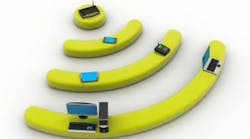If you heard author and futurist Walt Boyes speak at the Yokogawa users' group in September, or read about it at ControlGlobal.com, you heard Walt describe a future where wireless networks for measurement and control are the norm, owing largely to the high cost of copper. Given the trends in consumer devices, perhaps you find Walt's forecast entirely plausible. But would you say this future is imminent?
Most of our plants, even the huge new refinery being constructed in Calgary, have or will have a large installed base of wired devices, whether they're old-school 4-20 mA or a bus technology like Modbus, Profibus or Foundation fieldbus.
Also Read: "Can we make the jump to a wireless plant?"
When our folks learned we had the infrastructure installed for WirelessHART, their imaginations went off the leash. Surely it would be easy, cheap and convenient if they needed a local analog indication, some pushbuttons and some pilot lights in a few little, local panels?
My imagination must have been wandering beyond the range of my shock-collar also because I'd hoped the Rosemount 702 supported two discrete inputs as well as two discrete outputs. So when I learned that the 702 supported in fact two discrete inputs or two discrete outputs, I had to revise my estimate for the wireless solution. I couldn't do each panel with a single wireless device; I would need two.
If you're going to control outputs over wireless, at least with the 702, you're probably going to need interposing relays and some auxiliary power. You could also use AC power for the controlled devices if you wanted, but the dream-crushing reality is this wireless approach isn't devoid of wires. The elegance and simplicity of our wireless imagination still needs infrastructure from the wired world.
Then there was the issue of a local analog indication. The desired measurement was already present (calculated) in the DCS. We just needed to repeat it in the field. So far I haven't found a WirelessHART device that would indicate a measurement other than the one it was making.
The utility of a wireless local indicator poses some issues, even if one existed. How timely are the updates? If I make a move with a manual valve, how long before I see the effects? Perhaps these challenges explain why we don't have any yet. The local indication would have to be fieldbus. Either the Endress+Hauser RID14 or the Rosemount 752 would give me a nice configurable local indication on a single pair, routed from a relatively nearby fieldbus device or junction box on a segment with some spare capacity.
More wires. Even for the wireless solution, I was running a twisted pair into the vicinity. This set me on some wired alternatives, and I soon found a fieldbus device—available in both FF and PA—that provided two discrete inputs, two discrete outputs and an analog output, all in one relay-sized DIN-rail cube, the StoneL IM465015A. Available at a fraction of the cost, we were compelled to let go of our slick wireless solution and use a wired one.
In Walt's future plant, this whole endeavor might become moot. If operators have heads-up displays of all DCS data on hazardous-area-capable "Google Goggles," will local indicators and interfaces be obsolete? It's great that WirelessHART and ISA 100.11a have inspired our imaginations, but in the meantime, it appears we're still going to keep the copper wire and cable market churning.






